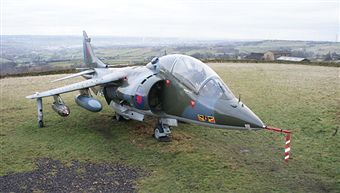 Lord Owen, among others, has responded to Colonel Gaddafi’s bloodcurdling lunacy
by insisting that a no-fly zone be imposed over Libya. But, as Con Coughlin has suggested, it is unlikely that Britain could support such an
operation without a fixed-wing attached to an aircraft carrier. The debate about the Strategic Defence Review and Britain’s military capability has reopened.
Lord Owen, among others, has responded to Colonel Gaddafi’s bloodcurdling lunacy
by insisting that a no-fly zone be imposed over Libya. But, as Con Coughlin has suggested, it is unlikely that Britain could support such an
operation without a fixed-wing attached to an aircraft carrier. The debate about the Strategic Defence Review and Britain’s military capability has reopened.
The SDSR put Afghanistan first. As armed Forces Minister Nick Harvey explained in a recent speech to RUSI:
‘Throughout the next few years, the mission in Afghanistan remains our main effort. Having made this commitment in the SDSR, this shaped many of our other decisions: the proposed changes to the Army, for example; and the preference for Tornado over Harrier.’
But, in an extensive letter in today’s Telegraph, former top brass and eminent defence analysts have delivered a precise critique of that preference. They assert that Harrier is ‘the most rapid and reliable response to urgent tasking in support of ground forces in Afghanistan.’
Independent analysis supports those claims. Back in 2007, the MoD commissioned the National Audit Office to compare the two aircraft. It found that the upgraded Harrier operated at close to 100 per cent of its capacity, while the ageing Tornado had fallen back. Tornado also struggles to reach its potential in dry and dusty climates. These factors explain why, in theatre, Harrier takes roughly 12 minutes to scramble, whilst Tornado has been known to take more than 30 minutes. (Some independent analysts claim that Tornado squadrons need up to 24 hours notice to prepare for close air support requests.)
In light of this, it’s unsurprising that the most recent Post Operation Reports from Afghanistan, which are submitted by commanding officers of infantry units on the ground and are therefore not in the public domain, state that Tornado frequently fails to deliver air support. The letter puts a number on this:
‘Tornado failed to satisfy more requested ground support missions in one month than did the Harrier in five years.’
Harrier can take-off from virtually anywhere and its flexibility and reliability are points in its favour. The specialists also argue in their letter that Harrier is significantly cheaper to maintain than Tornado. Referring to an official MoD audit, they say:
‘Keeping 40 Tornado & 40 Harrier (but using a higher level of productivity to compensate for a smaller fleet) for 4 years costs c £981 million. This is approx the same as the cost of maintaining 60 Tornados only for 4 years and produces a Force Element at Readiness of 24 aircraft rather than just 12 with the Tornado option. The Harrier establishment would allow Britain to provide 3 flights of eight aircraft; if necessary one operating in Afghanistan, one available for contingency embarkation in HMS Illustrious and one at home providing for pilot and ground crew training.’
They offer numerous other combinations to enhance Britain’s fixed-wing capability, but there is a delicate political problem here. The Libyan crisis has concentrated minds at the MoD; but a u-turn on Harrier is extremely unlikely. Costed plans are already in motion and David Cameron has associated himself closely with Harrier’s decommissioning. The letter writers consider the American F/A18 Super Hornet to be a possible alternative to Harrier before the introduction of the Joint Strike Fighter; I suspect that the government will examine the option in the immediate future.






Comments